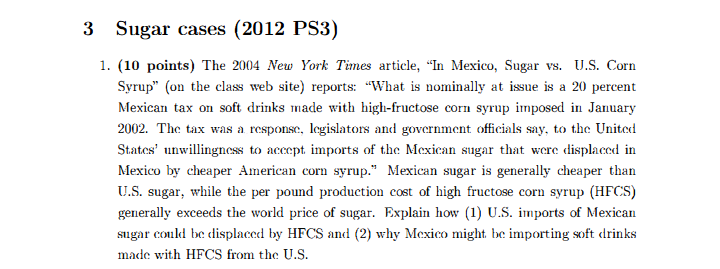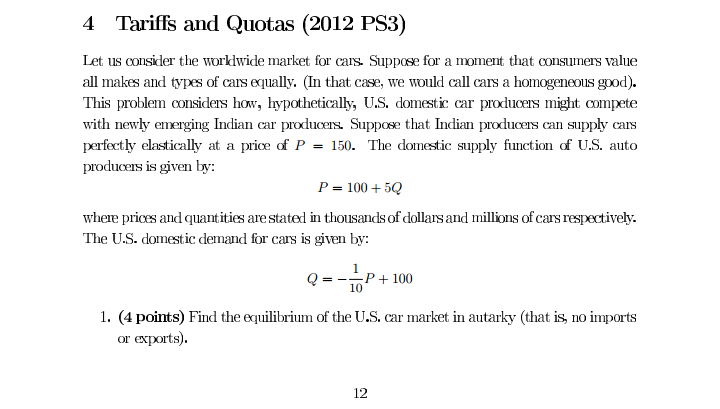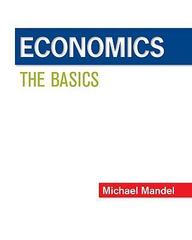SShow Answer clearly
3 Sugar cases (2012 PS3) 1. (10 points) The 2004 New York Times article, "In Mexico, Sugar vs. U.S. Corn Syrup" (on the class web site) reports: "What is nominally at issue is a 20 percent Mexican tax on soft drinks made with high-fructose corn syrup imposed in January 2002. The tax was a response, legislators and government officials say, to the United States' unwillingness to accept imports of the Mexican sugar that were displaced in Mexico by cheaper American corn syrup." Mexican sugar is generally cheaper than U.S. sugar, while the per pound production cost of high fructose corn syrup (HFCS) generally exceeds the world price of sugar. Explain how (1) U.S. imports of Mexican sugar could be displaced by HFCS and (2) why Mexico might be importing soft drinks made with HFCS from the U.S.2. (10 points) Imagine that the U.S. sugar program were ended today. Putting aside the issue of the surplus lost by producers and gained by consumers, this policy change would reduce employment in sugar cane and sugar beet farming, remove close to a million acres of U.S. land from sugar production, and reduce demand for HFCS. Reasoning from the principle that "all costs are opportunity costs," how should we think about the economic 11 costs of this policy change for workers in the sugar industry, owners of land used for cane and beet production, and firms that have built HFCS plants? [Note: this question does not have a trivial answer. Think carefully about the opportunity cost of each of these factors.]4 Tariffs and Quotas (2012 PS3) Let us consider the worldwide market for cars. Suppose for a moment that consumers value all makes and types of cars equally. (In that case, we would call cars a homogeneous good). This problem considers how, hypothetically, U.S. domestic car producers might compete with newly emerging Indian car producers. Suppose that Indian producers can supply cars perfectly elastically at a price of P = 150. The domestic supply function of U.S. auto producers is given by: P = 100 + 5Q where prices and quantities are stated in thousands of dollars and millions of cars respectively. The U.S. domestic demand for cars is given by: Q = P + 100 10 1. (4 points) Find the equilibrium of the U.S. car market in autarky (that is, no imports or exports). 122. (4 points) Now suppose the US opened its market to trade and allowed Indian man- facturers to import their cars to the US without any additional tariffs or quotas. Find the new equilibrium. How many cars would U.S. manufacturers produce and at what prices would they sell them? How many cars would be imported? Indian producers would be willing to supply as many cars as they can sell at P = 150.imported. 3. (4 points) Suppose that the US car manufacturers are concerned that they are not competitive with the Indian manufacturers and lobby the government to establish a tariff on Indian car exports of t = 100. How would this tariff change the equilibrium prices and quantities of cars sold by US manufacturers?imported. Note that in addition the government will collect T = 100 * imports = 4500 4. (4 points) Now suppose instead of the tariff, the government used a quota instead. Calculate the quota that would result in the same equilibrium quantity of U.S. produc- tion as the t = 100 tariff.5. (4 points) After the US introduced the tariff in part (3), the Indian government decided to provide a subsidy of s = 50 per car to its producers, so that they could sell at an even lower price. How would that change the equilibrium? How much does Indian government spend on the subsidy? How much does US government collect in tariff













